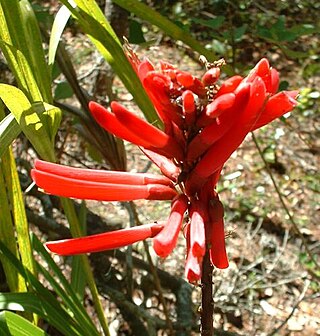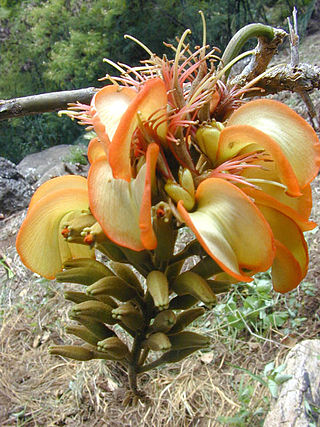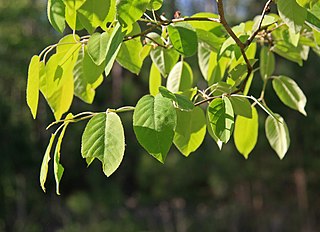
Erythrina is a genus of plants in the pea family, Fabaceae. It contains about 130 species, which are distributed in tropical and subtropical regions worldwide. They are trees, with the larger species growing up to 30 m (98 ft) in height. The generic name is derived from the Greek word ερυθρóς erythros, meaning "red", referring to the flower color of certain species.

Erythrina herbacea, commonly known as the coral bean, Cherokee bean, Mamou plant in South Louisiana, red cardinal or cardinal spear, is a flowering shrub or small tree found throughout the southeastern United States and northeastern Mexico; it has also been reported from parts of Central America and, as an introduced species, from Pakistan. Various other systematic names have been used for this plant in the past, including Erythrina arborea, Erythrina hederifolia, Erythrina humilis, Erythrina rubicunda, Corallodendron herbaceum and Xyphanthus hederifolius.

Wiliwili, is a species of tree in the pea family, Fabaceae, that is endemic to the Hawaiian Islands. It is the only species of Erythrina that naturally occurs there. It is typically found in Hawaiian tropical dry forests on leeward island slopes up to an elevation of 600 m (2,000 ft).

Amelanchier arborea, is native to eastern North America from the Gulf Coast north to Thunder Bay in Ontario and Lake St. John in Quebec, and west to Texas and Minnesota.

Conocarpus erectus, commonly called buttonwood or button mangrove, is a species of mangrove shrub in the family Combretaceae. It grows on shorelines in tropical and subtropical regions around the world.

Hibiscus tiliaceus, commonly known as the sea hibiscus or coast cottonwood, is a species of flowering tree in the mallow family, Malvaceae, with a pantropical distribution along coastlines. It has also been introduced to Florida and New Zealand. It has been debated whether this species is native or introduced to Hawaii.

Caesalpinia pulcherrima is a species of flowering plant in the pea family Fabaceae, native to the tropics and subtropics of the Americas. It could be native to the West Indies, but its exact origin is unknown due to widespread cultivation. Common names for this species include poinciana, peacock flower, red bird of paradise, Mexican bird of paradise, dwarf poinciana, pride of Barbados, flos pavonis, and flamboyant-de-jardin. The Hawaiian name for this plant is ʻohai aliʻi.

Erythrina variegata, commonly known as tiger's claw or Indian coral tree, is a species of Erythrina native to the tropical and subtropical regions of eastern Africa, the Indian subcontinent, northern Australia, and the islands of the Indian Ocean and the western Pacific Ocean east to Fiji.

Prosopis glandulosa, commonly known as honey mesquite, is a species of small to medium-sized, thorny shrub or tree in the legume family (Fabaceae).

Adenium obesum is a poisonous species of flowering plant belonging to the tribe Nerieae of the subfamily Apocynoideae of the dogbane family, Apocynaceae. It is native to the Sahel regions south of the Sahara, tropical and subtropical eastern and southern Africa and also the Arabian Peninsula. Common names include Sabi star, kudu, mock azalea, impala lily and desert rose. Adenium obesum is a popular houseplant and bonsai in temperate regions.

Erythrina vespertilio is a tree native to north and north-east Australia. Its common names are grey corkwood, bat's wing coral tree, yulbah and the more ambiguous "bean tree". In the Western Desert language it is also known as ininti.

Erythrina coralloides is a species of flowering tree in the pea family, Fabaceae, that is native to eastern Mexico. It ranges from Tamaulipas south to Oaxaca, and some taxonomists believe it is also native to southern Arizona in the United States.

Dalbergia sissoo, known commonly as North Indian rosewood or shisham, is a fast-growing, hardy, deciduous rosewood tree native to the Indian subcontinent and southern Iran. D. sissoo is a large, crooked tree with long, leathery leaves and whitish or pink flowers.
Erythrina schliebenii is a species of legume in the family Fabaceae. It is found only in Tanzania. The species is named for German collector and botanist Hans-Joachim Schlieben.

Khaya anthotheca, with the common name East African mahogany, is a large tree species in the Meliaceae family, native to tropical Africa.

Khaya senegalensis is a species of tree in the Meliaceae family that is native to Africa. Common names include African mahogany, dry zone mahogany, Gambia mahogany, khaya wood, Senegal mahogany, cailcedrat, acajou, djalla, and bois rouge.

Boscia senegalensis, commonly known as hanza, is a member of the family Capparaceae.

Annona senegalensis, commonly known as African custard-apple, wild custard apple, wild soursop, abo ibobo, sunkungo, and dorgot is a species of flowering plant in the custard apple family, Annonaceae. The specific epithet, senegalensis, translates to mean "of Senegal", the country where the type specimen was collected.

Saba senegalensis, known as weda in the Moore, French, and English languages, is a fruit-producing plant of the Apocynaceae family, native to the Sahel region of sub-Saharan Africa. It has several common names in various West African Languages. The tree grows predominantly on riverbanks and in woodlands in The Gambia, Guinea-Bissau, Burkina Faso, Senegal, Somalia, Mali and Ivory Coast. It has been observed growing as vine up trees, as a small erect shrub, and oftentimes growing to the size of a large tree.

Holarrhena floribunda, commonly known as the false rubber tree, conessi bark or kurchi bark, is a plant in the family Apocynaceae.




















